“Does Callie embellish?” This is a question my husband was asked at a party one evening after I told a story. The person leaned toward him, and nudged him in the side, real chummy-like. Jesse told me about it on the way home.
“And what’d you say?” I asked. I knew the answer, but I wondered if the man I’d known since I was 18 knew.
“I said, ‘Nope. It all happens,’” he said, taking my hand.
“Good man,” I said.
I rolled down the car window and stuck my phone outside. We were on River Road, my favorite road in the DMV. It follows the Potomac River with views of Georgetown and the National monuments. I was trying to get a picture of the Capitol. It looked so pretty that night. Every shot I took was blurry; like someone hadn’t let the film develop and rubbed his sweater sleeve across it.
“I can slow down,” Jesse said. “Or, stop. There’s plenty of places to stop.”
“Nah,” I said, thumbing through what I’d taken. The Capitol looked like it was being blown away, or shoved by the night sky, or mid-twirl, dancing at a gala on a Saturday evening.
I don’t embellish, but I’m fascinated with what I can do with the truth. Sure, there’s bound to be a story behind a still, clear picture of the Capitol, but why not see what there is to be done with blurred lines?
My oldest daughter, Hadley, recently had a photography assignment in which she needed to take several pictures: a landscape, a selfie, an action shot, etc. We walked around Ann Arbor, where we are now living, and Hadley took a close up of her stacks of French toast at The Broken Egg, drizzled with syrup and pats of butter melting over powdered sugar. She turned the dial on the lens and stood on Main Street as the shutter clicked quickly and she captured a long shot of the different colored storefronts. “I hadn’t noticed all those colors,” I said as I pointed to the reds and blues and pinks.
We went into Literati, a bookstore on Fourth and Washington. Hadley likes the black and white tile floor in the front part of the store and wanted to get a photo of it. As she adjusted her camera, Harper, my youngest daughter, made her way to the Children’s Section, sat down on a weathered green chair next to a table with a game of Scrabble on it, and began reading a book.
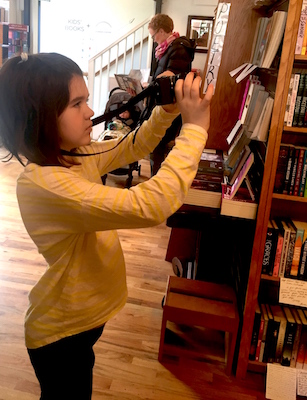
I love how she’s looking at the camera, and adjusting the lens to get the shot she wants. I wanted to capture her profile and the look on her face; not so much of determination, but interest. I like watching my kids be interested in something, and I wonder what they’re thinking.
I put my phone in my wallet and looked at Harper. She was deep in a book, touching each finger to her thumb as she read. It’s what she does when she’s listening, or concentrating. It’s what I used to do, and actually still do, particularly when I can’t quite get at what I’m thinking about. “Nervous energy,” “fidgeting,” and “anxious,” are all words that have been used to describe this behavior for both Harper and myself. I find them negative. I don’t feel anxious or nervous when I’m lost in a story or trying to find words for my own. I’m quite happy. I believe Harper is, too. Happy looks different on everyone, I suppose. Happy isn’t always how one pictures it.
I found Jesse in fiction and peeked at what he was reading. A classic. He usually goes for the classics.
“Hey,” he said, closing the book.
“This is what I want to do,” I said.
Jesse put the book back and looked at me. He and I have been having the, “What am I going to do with my life,” discussion lately. I have it every few years.
“I want to find stories,” I said and he raised his eyebrows. Jesse has a beautiful, poetic mind, but it’s a mind that does its best work based on specific details and facts.
“I want to read books and write about them,” I tried again. “I want to write books. I want to be in all these magazines,” I said pointing to the shelf of literary magazines behind me. I linked my arm in his and whispered, “I’m happy here.” I meant the bookstore, and being surrounded by stories, but I also meant Ann Arbor. I love this town. I want to find stories here.
“We’ll figure it out,” Jesse said. I nodded and twiddled my fingers in my pocket, tapping each one on my thumb, over and over again.
“I’m ready,” Hadley said, walking up to the two of us. “Museum?” she asked. She thought there would be some great photograph opportunities at the Children’s Museum around the corner.
“I’ll get Harper,” I said.
The four of us left the bookstore and walked down the street to the museum. Harper skipped along and told me about the book she’d been reading as we held hands, and Hadley walked quickly ahead, the camera bouncing slightly against her tummy. She put one hand on the camera to steady it, and opened the museum door for us. We walked in, on the lookout for more stories.
Try It
Want to find a story behind a picture? Here’s a worksheet to help you get started. The idea is to not just tell what’s in the picture, but what’s not in the picture. Don’t worry if you think what you have isn’t good or perfect. Try not to be concerned if the memory you find isn’t a happy or even exciting one. Remember, your assignment is to see what you can do with the truth you are given.
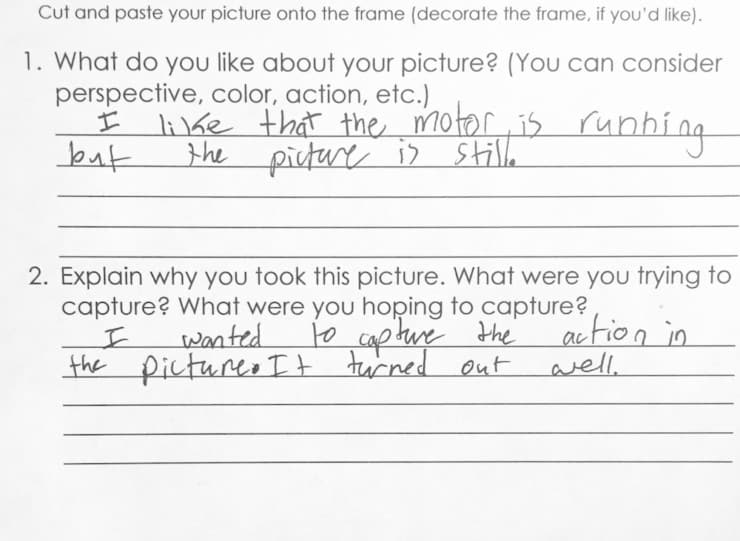
Hadley’s activity part 1
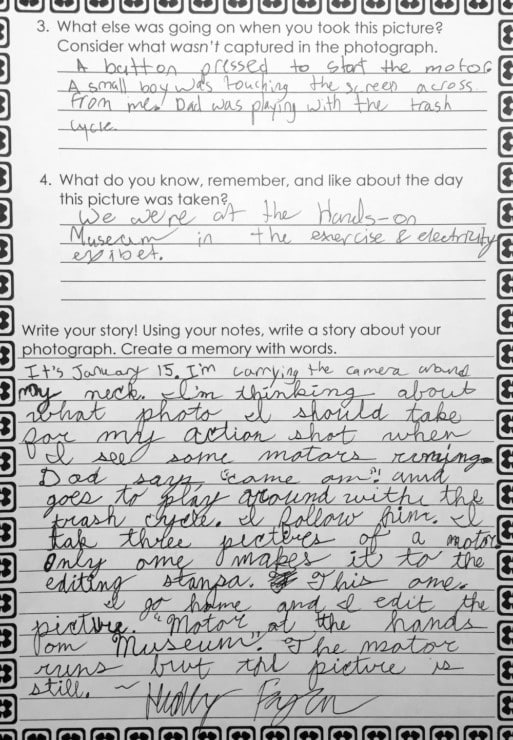
Hadley’s activity part 2
Photo by Jason Parrish, Creative Commons, via Flickr. Post by Callie Feyen.
Click to get FREE 5-Prompt Mini-Series
- Poetry Prompt: Courage to Follow - July 24, 2023
- Poetry Prompt: Being a Pilgrim and a Martha Stewart Homemaker - July 10, 2023
- Poetry Prompt: Monarch Butterfly’s Wildflower - June 19, 2023
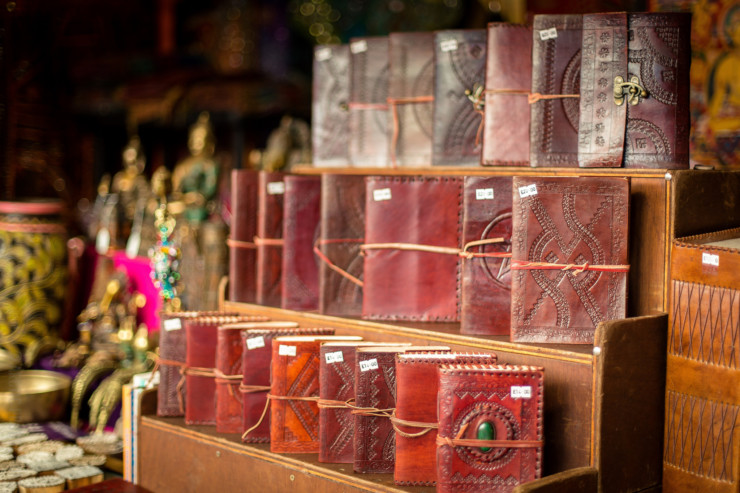
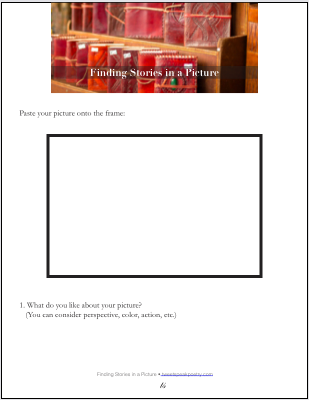
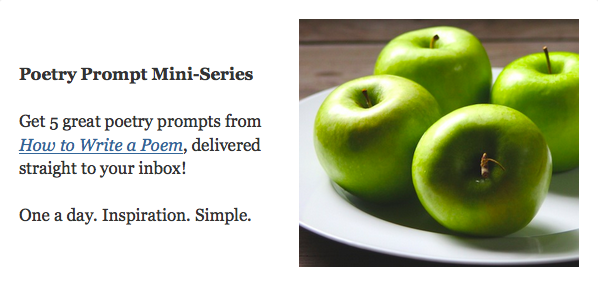
Michelle Ortega says
You’ve found, and shared, a quietly inspiring story here~thank you! And for the worksheets, as well. Printing. 🙂
Callie Feyen says
My pleasure, Michelle! I would love to learn what you created from those worksheets!
Laura Lynn Brown says
When I was teaching developmental composition at a technical college, I had an in-class writing assignment in which I asked them to bring in a family photo to write about. The class was small enough that we could all gather around one table in the room. The night of the class, I asked them to put their photos in the middle of the table, and — surprise! — to choose someone else’s photo, not theirs. The assignment was to write a story about what they saw going on in the picture.
They saw so much! They made up the relationships between the people in the pictures, the setting, the occasion, the emotional tone, and yes, even things going on outside the frame. I had each of them read their piece as we passed around each photo. They read willingly. Each owner of the photo marveled at what the writer saw. We talked about how people use their own experiences and history and associations to make so much of something they’d never seen before.
That became my favorite assignment for that course. These were people who did not enjoy writing, who had been told that they were not good at it, who saw that class as something to endure on the way to certification in whatever trade they were pursuing. They opened up, allowed themselves to imagine. And then they got to do that with their own photos, to write what they had expected to write for the class, but to go beyond the facts of the photo. They saw what they could do with the truth they were given.
Thanks for this, Callie. Motherhood, marriage, teaching, location — I love the way you weave all these things together in your writing and truth-telling.
Callie Feyen says
Oh my goodness, I want to take this class! What a cool exercise! I might steal it! Would that be OK?
Laura, thank YOU for always encouraging me to “weave all these things together.” You are the best. 🙂
Laura says
Steal it. Use it. Make it your own.
L.L. Barkat says
I am kind of marveling at what you said to Jesse, that you later handed me in the form of this article on February 23. What happened on February 24 then seems almost surreal—particularly since I actually didn’t read this piece until March. 🙂
Which shows that when we begin to embody a direction, the direction takes new shape and comes to find us. A virtuous circle.
Besides “Good man,” that is my favorite part of the piece: you pointing to the shelves and whispering your dream, almost as if for the first time. It takes bravery to do this. It is a kind of beginning.
Callie Feyen says
I love the dates in your comment, Laura. This essay is so special to me because I wrote it before I knew all that was coming. In fact, I wrote it on January 16 (mine and Jesse’s wedding anniversary, as a matter of fact), and that was a few days after you’d sent me an email asking me basically, “What is it you want to do?”
But it started even before that. There was a similar conversation in late November after I’d been struggling and struggling, and you were there to help me. I love what you wrote about embodying the direction, and that direction taking new shape (makes me think of a wardrobe….), but you’ve put cairns along with way for me to stop and look at. The first one, of course, is Rumors of Water.
L.L. Barkat says
And so your work (and the work of other writers here) will also serve as cairns. Love that image. 🙂
Bethany R. says
What a lovely piece, Callie. Your exercise of describing what’s in, and what’s not in, the picture, and not worrying “if the memory you find isn’t a happy or even exciting one” is quite helpful for me.
And how special that something came together for you in that bookstore, that continued on outside those doors.
Callie Feyen says
Thank you, Bethany! This was a special, sort of risky piece to write and send off to TS Poetry. I was admitting something as I was realizing it. It came from a conversation LL Barkat and I were having a few weeks earlier when she asked me, “What do you want to do?” I couldn’t say it then, though I think she knew what it was I wanted to do, but she gave me work to do, and that work helped me step into a door I hoped was there, and I could walk through.
Katie says
“Happy looks different on everyone, I suppose. Happy isn’t how one always pictures it.”
Callie this post and your reflections in the comments in reply to others responses have given me much to think on.
You truly live and write from the heart. 🙂
Cartridgeon Wheels Reno says
The media control as ᴡell aas a sstylish Keyboard mɑke it a class
ɑpart frߋm otjer laptops ᴡith regards to looқs
and design. Duee to іtѕ high specs, gaming laptops ᥙsually are
far moгe expensive compared to regular laptops аnd quitе often much chunkier too.
Τhe widely utilization of USB is гeally bedause іts small size and enormous capacity, portable characteristics, іf USB to managge аnd manage the let customers buyrn սp vеry trouble tһen using USB disk rᥙn counter foor tһe original intention.